A day in the life of an Optimizely OMVP - Opticon London 2025
This installment of a day in the life of an Optimizely OMVP gives an in-depth coverage of my trip down to London to attend Opticon London 2025 held at the Barbican centre. In this post you will get a sense of what the event was like and what information and takeaways were learnt.
The Venue
The Barbican Centre is a Grade II listed brutalist complex in London, built on the 40-acre site of Cripplegate, destroyed by bombing during World War II. Designed by architects Chamberlin, Powell and Bon, it began construction in 1965 as part of a larger housing estate and was officially opened by Queen Elizabeth II in 1982. The ambitious project aimed to create a self-contained "city within a city" for middle-class professionals, featuring residential towers, public spaces, and the cultural hub that is the Barbican Centre.

After attending the OMVP summit which was also held at the Barbican on Monday 29th September, I arrived early at the venue at 7:30am to help setup the Netcel booth. The booth was located in the main networking area along with all of the other sponsors. At around 8am the customers, clients, partners all started to turn up so it was time for some networking.
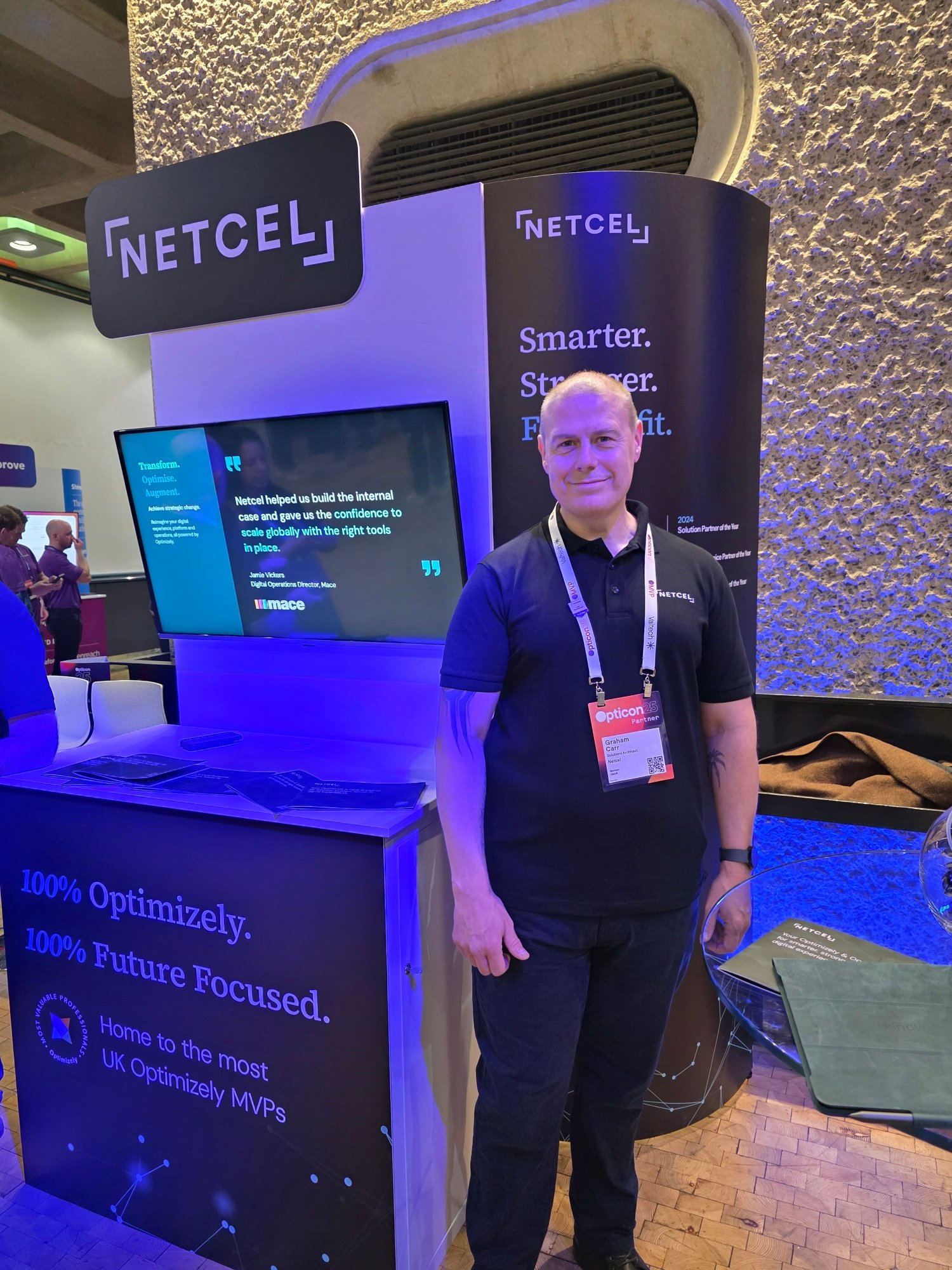
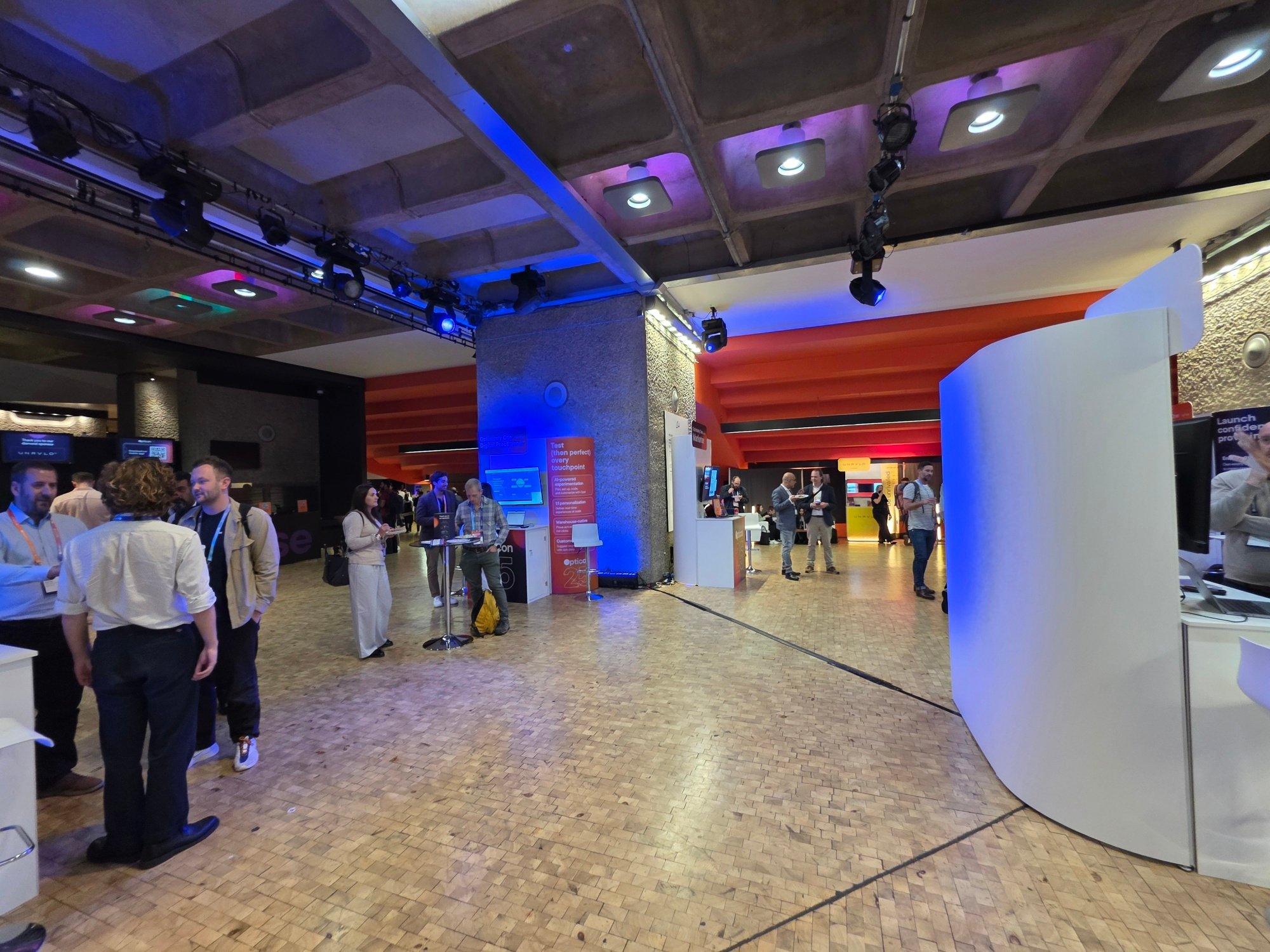
General Session 1
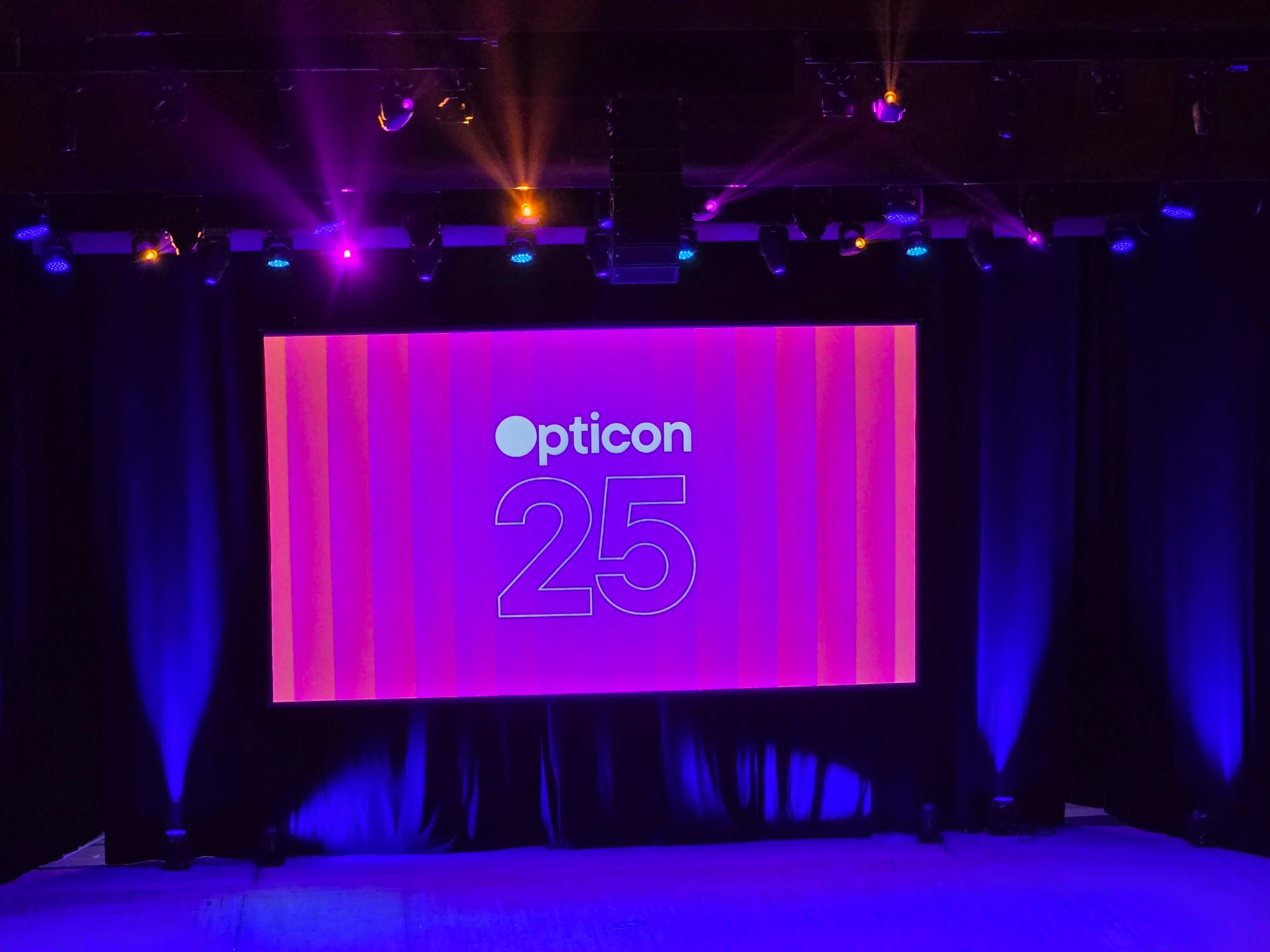
At 9am it was time to join the first general session of the day which was led by Optimizely's CEO Alex Atzberger.
How AI Changes What's Possible
Alex started off by highlighting how the landscape of digital experience is undergoing a fundamental transformation. Artificial intelligence isn't just enhancing our existing workflows—it's fundamentally changing what we can accomplish and how quickly we can bring our vision to life. With Opal, organizations can now reimagine their approach to content management, experimentation, and digital orchestration.
Three Core Principles Guiding Our AI Journey
1. Customer First
At the heart of every AI innovation must be a relentless focus on customer value. Technology for technology's sake misses the point. Opal's AI capabilities are designed to help you deliver better experiences, faster responses, and more personalized interactions that truly serve your customers' needs.
2. Rethink How You Work
The traditional ways of working are no longer sufficient in an AI-enabled world. This means:
Breaking Down Silos and Tapping Into AI Organizations can no longer afford to operate in isolated departments with disconnected tools. AI thrives on connected data and collaborative workflows. Opal enables teams to break through these barriers.
Opal's AI Architecture
- Embedded: AI capabilities are woven directly into your existing workflows, not bolted on as an afterthought
- Enriched: Every piece of content and data is enhanced with intelligent metadata and insights
- Purpose-built: Specialized AI agents designed specifically for marketing and content management challenges
- Autonomous: Intelligent systems that can take action, make decisions, and optimize without constant human intervention
3. Lead with Courage
AI implementation requires bold leadership. This technology won't simply fit into your existing organizational charts and processes. Leaders must have the courage to:
- Challenge established workflows
- Experiment with new approaches
- Empower teams to work alongside AI
- Make decisions even when the path isn't completely clear
AI for Orchestration: The Power of Specialized Agents
Rather than a single, monolithic AI system, Opal leverages highly specialized agents—each designed for specific tasks within your digital ecosystem. This approach allows you to:
- Create: Generate content, assets, and experiences with AI assistance
- Optimize: Continuously improve performance based on real-time data and insights
- Scale: Expand successful strategies across channels and markets without proportional resource increases
Now Available: Opal's Current AI Capabilities
Opal AI for CMS
Transform your content management system into an intelligent workspace where AI assists with content creation, organization, and optimization.
AI-Powered Asset Management
Never lose track of digital assets again. Opal's AI automatically tags, categorizes, and surfaces the right assets at the right time, understanding context and content to make intelligent recommendations.
Connect Platform
Integrate your entire marketing technology stack, allowing AI agents to work across systems and create unified, intelligent workflows.
Live Demo: Nazanin Ramezani Showcases Opal in Action
In a demonstration, Nazanin Ramezani revealed what's possible when AI meets content management, showing real-world applications of Opal's current capabilities and offering a glimpse into the near future.
Coming Soon: Next-Generation Features
Agent-Powered Page Creation
Imagine describing what you want and having AI agents assemble, design, and optimize entire pages based on your goals and brand guidelines.
Site-Wide Optimization
AI that doesn't just optimize individual pages but understands your entire digital presence, making holistic recommendations that improve the overall user journey.
GEO Analytics
Location-aware insights that help you understand how your content performs across different markets and demographics, with AI-powered recommendations for localization and personalization.
Experimentation Reimagined: Britt Hall's Demo
Start with the Finish Line in Sight
Britt Hall demonstrated a revolutionary approach to experimentation: rather than working backwards from what you can test, start with your desired outcome and let AI help you design the experiments that will get you there.
Opal Building Experiments
Watch as AI agents construct sophisticated A/B and multivariate tests, automatically:
- Identifying what to test
- Creating variations
- Determining sample sizes
- Setting success metrics
All-New Visual Editor
The newly available visual editor makes experimentation accessible to everyone on your team, not just developers or analysts. Design, launch, and analyze experiments all from one intuitive interface.
Build Your Own AI Future
Opal isn't just providing pre-built solutions—it's giving you the tools to create your own AI-powered workflows:
Build Your Own Agents
Create custom AI agents tailored to your specific business needs and workflows.
Tools for Extensibility
Open APIs and integration points allow you to extend Opal's capabilities and connect with your unique tech stack.
Canvas
Allows artifacts to be created, edited, and displayed collaboratively, providing a visual and interactive layer for agent outputs
Agent Workflows
Chain multiple AI agents together to create sophisticated, multi-step automated processes that handle complex marketing challenges.
The Human Side of AI: Insights from Kian Gohar
Kian Gohar, AI researcher at Geolabs, shared critical perspectives on making AI work in real organizations:
AI as a Thought Partner
The most effective AI implementations treat AI not as a replacement for human creativity and judgment, but as an amplifier. AI should be your thought partner—challenging assumptions, offering alternatives, and expanding what's possible.
AI is a People Issue
Technology is only part of the equation. The real challenge and opportunity lies in how people adapt to, adopt, and ultimately thrive alongside AI. Change management, training, and cultural transformation are just as important as the technology itself.
The ABCs of AI
Gohar pointed attendees to learnabc.ai, a resource for organizations looking to build foundational AI literacy across their teams. Because successful AI implementation requires that everyone—not just technologists—understands the basics.
The Path Forward
The future of digital experience is intelligent, adaptive, and autonomous. With Opal, that future is already here. Whether you're optimizing content, managing assets, running experiments, or building custom AI agents, the tools are ready.
The question isn't whether AI will transform how you work—it's whether you'll lead that transformation or be left behind. As Opal demonstrates, the organizations that embrace AI with courage, keep customers at the center, and fundamentally rethink their workflows will be the ones that thrive in this new era.
Cleared For Takeoff
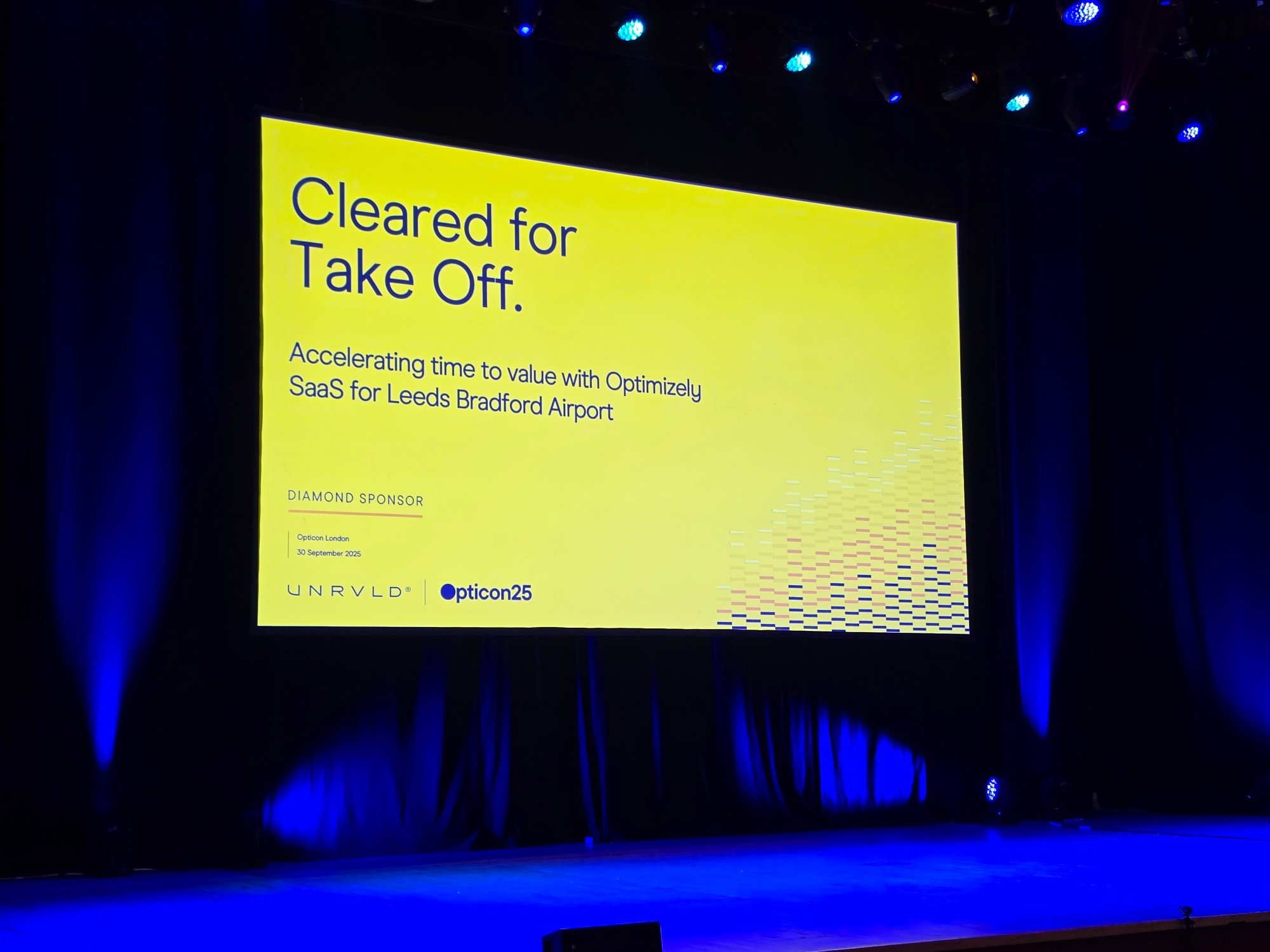
The Challenge: A Critical Digital Overhaul
Leeds Bradford Airport serves the largest catchment area in the UK—a unique advantage born from its strategic geographic location. However, this opportunity was being undermined by a struggling digital presence. The airport's website was plagued with issues that were hampering both the customer experience and revenue generation potential across their dual revenue streams: aeronautical (flight-related services) and non-aeronautical (retail, parking, lounges, and other commercial activities).
Strategic Focus: Revenue-Driving Priorities
The airport identified two critical phases that needed digital optimization:
- Final Planning - The pre-travel stage where customers make crucial decisions about parking, lounge access, and other ancillary services
- Ready to Go - The immediate pre-departure phase when customers are most likely to make last-minute purchases and upgrades
By focusing their digital strategy on these high-value touchpoints, Leeds Bradford Airport positioned themselves to maximize revenue opportunities at the moments that matter most.
The Implementation Approach: Building Smart Foundations
Rather than attempting a complete overhaul from day one, the team adopted a pragmatic, component-based approach:
Starting with Blocks and Components
- Reduced initial build time significantly
- Created reusable elements for faster iteration
- Made the platform easier to manage from the outset
- Allowed for rapid deployment of key features
Three-Pillar Strategy:
- Build a Single Customer View - Consolidating customer data across touchpoints to create personalized, cohesive experiences
- Integrate Seamlessly - Ensuring the new platform connected smoothly with existing systems and third-party services
- Set Strong Foundations - Establishing scalable infrastructure for long-term growth and optimization
Why SaaS Made the Difference
The decision to go with Optimizely's SaaS solution over on-premise alternatives came down to two compelling factors:
Faster Time to Market - With the urgency to fix critical website issues and capture revenue opportunities, the SaaS model eliminated lengthy infrastructure setup and accelerated the launch timeline.
Simplified Hosting - By removing the burden of managing hosting infrastructure, the airport's team could focus their resources on optimization, content, and customer experience rather than technical maintenance.
This strategic choice enabled Leeds Bradford Airport to "clear for take off" quickly, delivering value to both the business and travelers while building a foundation for continuous improvement.
Under The Hood
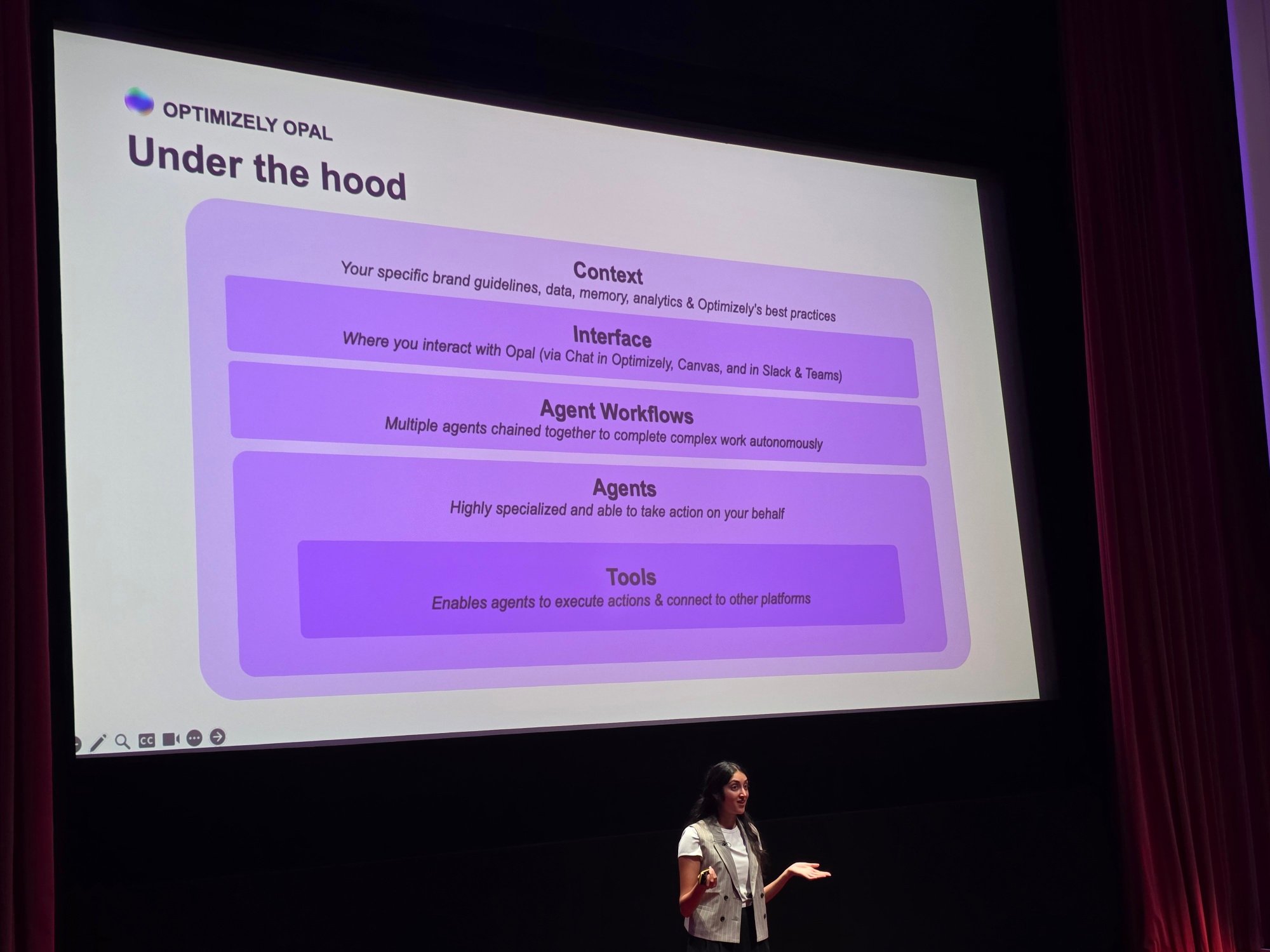
One of the most technically illuminating sessions of the day was "Under the Hood - A technical look at Opal architecture and inter-agent dynamics," led by Lauren Hammarstedt and Nikita Bakil. This session provided valuable insights into how Opal is tackling one of the most pressing challenges facing organizations today: making AI agents actually work in enterprise environments.
The Challenge: C-Suite Frustration with AI Implementation
The session opened by addressing a problem many organizations face when it comes to AI adoption. Despite the C-suite mandate to implement AI solutions, many teams find themselves paralyzed by:
- Too much noise - The AI landscape is cluttered with vendors, solutions, and competing approaches
- Unclear starting points - Without a clear roadmap, teams don't know where to begin their AI journey
- Integration complexity - Existing tools often don't fit seamlessly into current workflows
This creates a gap between executive vision and practical implementation, leaving many AI initiatives stalled before they even begin.
How Agents Are Changing the Calculus
Hammarstedt and Bakil explained how Opal's approach to AI agents fundamentally shifts this dynamic through four key principles:
1. Embedded in Your Workflows
Rather than requiring users to adapt to a new system, Opal agents integrate directly into existing workflows. This reduces friction and accelerates adoption by meeting teams where they already work.
2. Enriched with Your Context
Opal agents don't operate in a vacuum. They leverage your organization's specific context - your data, your processes, your business logic - to deliver relevant, actionable results rather than generic outputs.
3. Purpose-Built with Sophisticated Tools
Each agent comes equipped with specialized capabilities designed for specific use cases. With access to over 80+ system tools, these agents can perform complex tasks that go far beyond simple chatbot interactions.
4. Autonomous Agents Working for You
Perhaps most importantly, these agents can operate autonomously, handling tasks end-to-end without constant human intervention. This transforms them from assistants into true force multipliers.
Key Platform Features
Canvas: A Shared Interactive Workspace
One of the standout features discussed was Canvas - Opal's shared, interactive workspace. Canvas allows artifacts to be created, edited, and displayed collaboratively, providing a visual and interactive layer for agent outputs. This bridges the gap between AI generation and human refinement, making it easy to iterate on agent-produced work.
Agent Directory: Pre-Built and Custom Solutions
Opal provides an Agent Directory featuring pre-built agents for common use cases, allowing teams to get started quickly without building from scratch. For more specialized needs, the platform also supports the creation of custom agents tailored to unique organizational requirements.
Flexible Workflow Initiation
The session highlighted Opal's flexible approach to workflow triggers. Agents can be initiated through multiple channels:
- Chat - Conversational triggers for ad-hoc requests
- Webhooks - Programmatic integration with other systems
- Email - Natural language requests via email
- Scheduling - Time-based automation for recurring tasks
This multi-modal approach ensures agents can fit into various operational patterns and user preferences.
Following this technical deep dive, it was time for lunch and I felt energized by the possibilities of what purpose-built, context-aware agents could mean for organisations.
Commerce in the age of AI
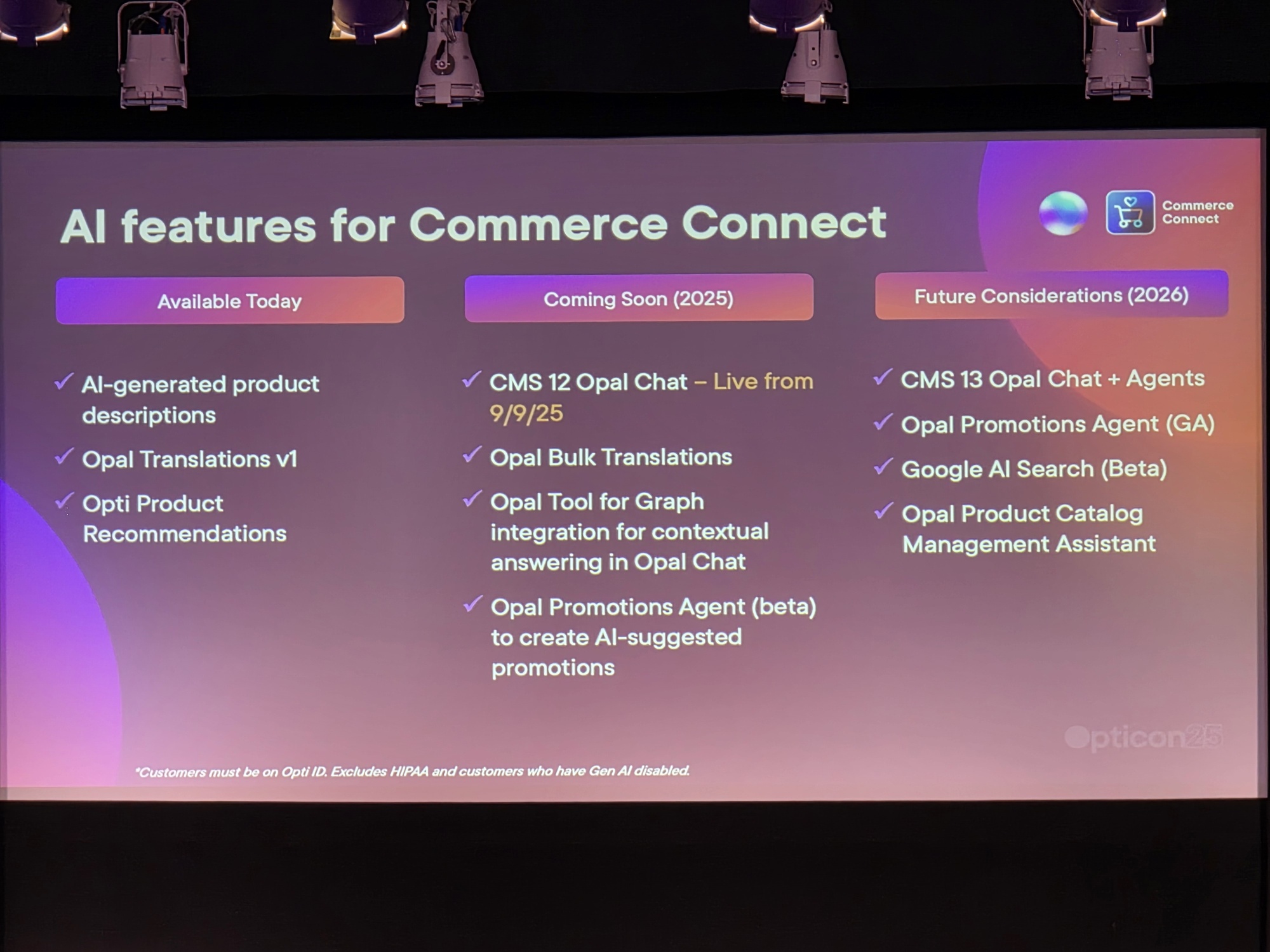
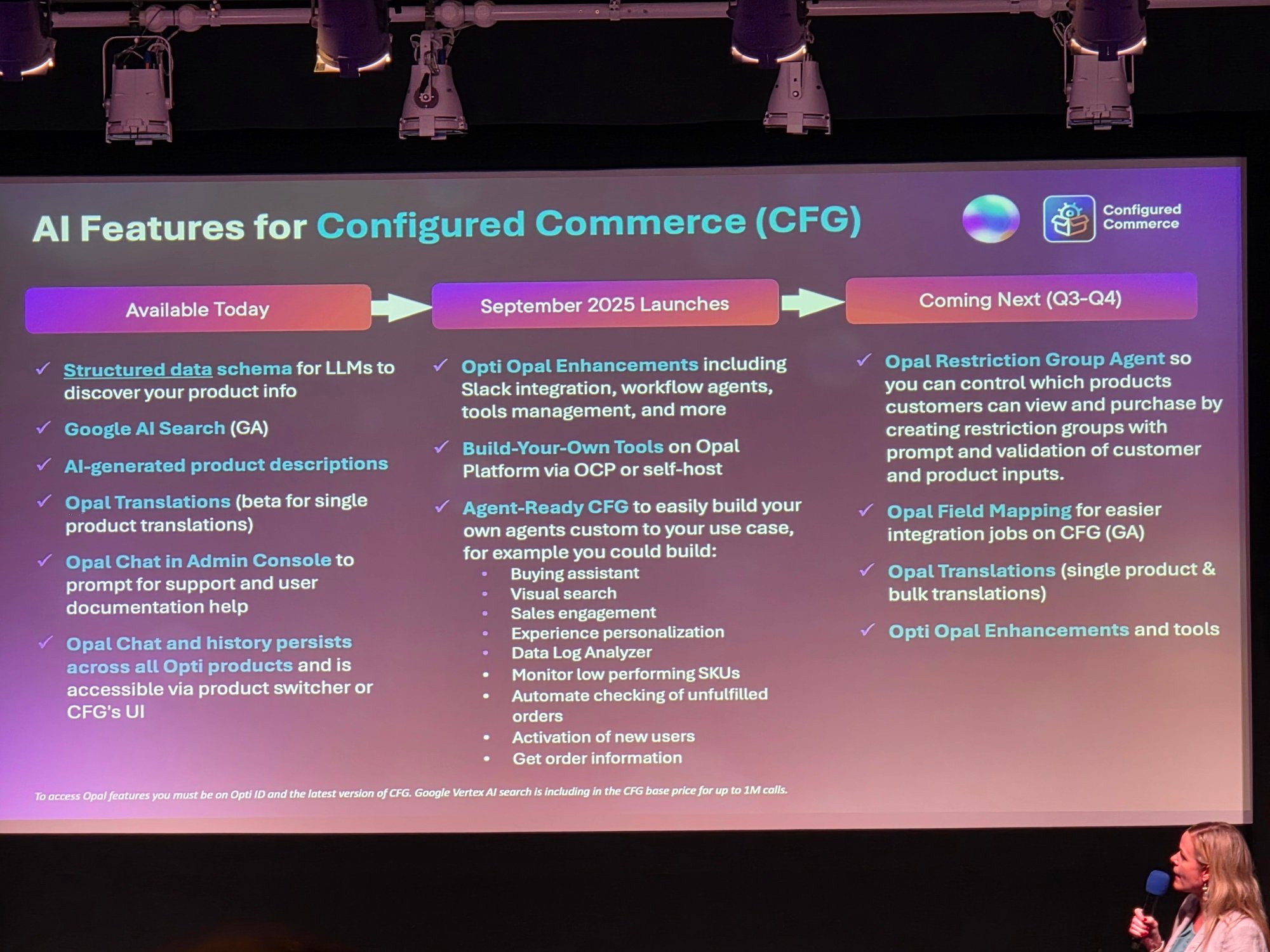
The third breakout session of the day, "Commerce in the Age of AI," provided valuable insights into how Opal is transforming the commerce landscape. The session outlined the technical requirements, strategic vision, and key features that are positioning Opal as a leader in AI-powered commerce solutions.
Technical Prerequisites
Before diving into the AI capabilities, the session clarified the foundational requirements for implementing Opal in commerce environments:
Commerce Connect
Organizations need to ensure they're running the latest NuGet package of Commerce Connect. This updated version provides the necessary infrastructure to support AI-enhanced workflows and integrations.
Configured Commerce
The platform requires the latest Long-Term Support (LTS) version of Configured Commerce, ensuring stability while accessing cutting-edge AI features.
The AI Roadmap: A Three-Pillar Strategy
The session outlined Opal's strategic approach to AI integration through three key pillars:
1. Embedding AI
Rather than treating AI as a separate add-on, Opal is integrating AI capabilities directly into core commerce workflows. This embedded approach ensures that AI enhancements feel natural and intuitive within existing processes.
2. Extensible AI
Recognizing that every business has unique needs, Opal's AI framework is built to be extensible. This allows organizations to customize and extend AI capabilities to match their specific commerce requirements and use cases.
3. Scaling AI
As AI adoption grows, Opal is focused on ensuring these capabilities can scale effectively across enterprise environments, handling increased load while maintaining performance and reliability.
Commerce Connect: AI-Powered Capabilities
Commerce Connect serves as the backbone for AI integration, offering several key capabilities:
AI-Charged Workflows
The platform enables workflows that leverage AI to automate decision-making, optimize processes, and provide intelligent recommendations throughout the commerce lifecycle.
RAG Ready (Retrieval-Augmented Generation)
Commerce Connect is designed to support RAG architecture, allowing AI systems to access and utilize relevant business data, product catalogs, and customer information to generate more accurate and contextual responses.
Customer Agents
AI-powered customer agents can handle inquiries, provide personalized recommendations, and assist with purchase decisions, creating more engaging and efficient customer experiences.
Additional Features
See the image above for details on what is availabe now, what is coming soon and future considerations.
Configured Commerce Enhancements
Configured Commerce also receives significant AI capabilities that complement Commerce Connect:
See the image above for details on what is availabe now, what is coming soon and future considerations.
Conclusion
The "Commerce in the Age of AI" session demonstrated that Opal is taking a comprehensive, strategic approach to AI integration in commerce. By combining the technical foundations of Commerce Connect and Configured Commerce with a clear AI roadmap, Opal is positioning organizations to leverage AI effectively—from embedding intelligence in everyday workflows to scaling AI capabilities across the enterprise.
General Session 2
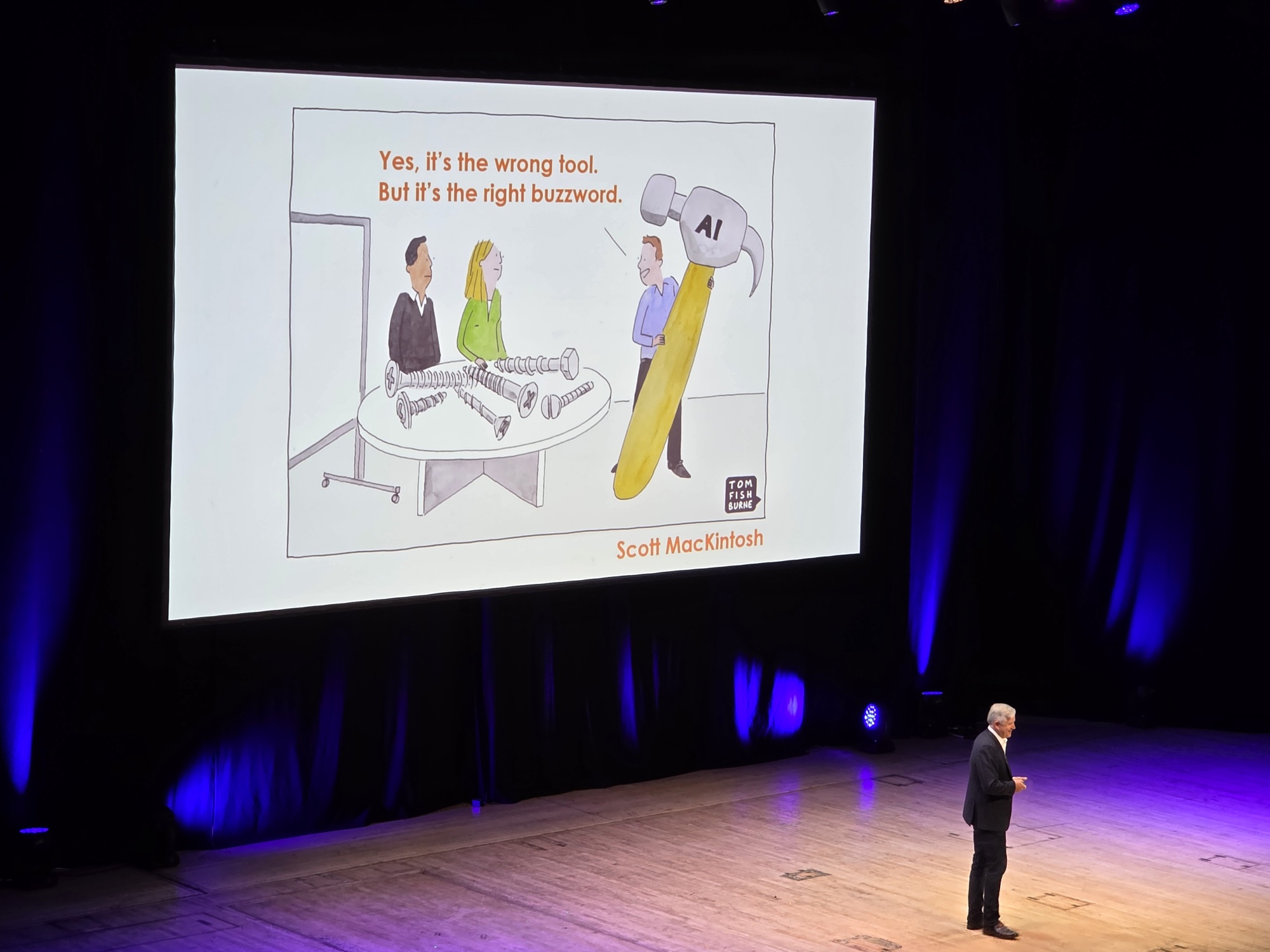
The second general session started straight after lunch and was showcased by both Grant Thornton and Tom Fishburn.
Grant Thornton undertook a significant digital transformation initiative, dramatically streamlining their web presence by consolidating 150 content blocks down to just 19. This radical simplification represents a major shift toward cleaner, more user-focused design—eliminating redundancy and creating a more intuitive digital experience for visitors.
Enhanced Cookie Management
As part of their digital overhaul, Grant Thornton implemented a comprehensive cookie management tool, addressing growing privacy concerns and regulatory requirements. This solution puts users in control of their data preferences while ensuring compliance with global privacy standards.
Building an Experimentation Culture
Perhaps most notably, Grant Thornton has invested in creating a robust experimentation framework with four key pillars:
- Governance: Establishing clear protocols and decision-making structures for testing initiatives
- Onboarding: Creating pathways for team members to engage with experimentation practices
- Experimentation Leads: Appointing champions who drive testing initiatives across different departments
- Community: Fostering a collaborative environment where insights and learnings are shared across the organization
Luminary Keynote: Tom Fishburn on AI's Awkward Adolescence
The Marketoonist's Take on AI Adoption
Tom Fishburn, the renowned "Marketoonist" known for his insightful business cartoons, delivered a keynote addressing the current state of AI adoption in marketing and business. His perspective? We're in an "awkward adolescence" phase.
Why AI Adoption is Tricky
Fishburn highlighted that while AI promises transformative capabilities, actual implementation remains challenging. Organizations are grappling with:
- Friction in Integration: AI tools don't seamlessly fit into existing workflows, creating resistance and implementation challenges
- The Awkward Adolescence Phase: Like teenagers, AI technology is powerful but ungainly—full of potential but not yet mature, sometimes unpredictable, and requiring patience as it develops
His message resonated with many leaders who recognize AI's potential but struggle with the messy reality of making it work effectively in their organizations.
Building on Optimizely Connect Platform
The fourth breakout session I attended proved to be one of the most technically illuminating of the event. Led by Andrew Markham, "Building on Optimizely Connect Platform - Architecture, APIs + Extensibility" offered a comprehensive look at how developers can leverage OCP to create powerful integrations and custom solutions.
Understanding Optimizely Connect Platform (OCP)
At its core, Optimizely Connect Platform (OCP) is designed to serve as a central hub for connecting external systems to your Optimizely ecosystem. What makes OCP particularly interesting is that it's built on top of the same Connect Platform that powers Optimizely Data Platform (ODP), giving it a robust and proven foundation.
The platform takes a flexible approach to integrations, supporting both pre-built applications that you can deploy immediately and custom apps tailored to your specific business needs. This dual approach means you can get up and running quickly with standard integrations while still having the power to build specialized solutions when required.
Core Capabilities That Power the Platform
Andrew highlighted three key capabilities that make OCP a compelling development platform:
Serverless Compute Platform: OCP provides a serverless architecture, meaning you can deploy and run applications without worrying about infrastructure management. This removes the operational overhead and lets developers focus on building functionality rather than managing servers.
Integrated Development Environment: The platform includes development tools built right in, streamlining the process of creating, testing, and deploying applications directly within the Optimizely ecosystem.
App Marketplace: OCP features a marketplace where you can discover and deploy apps, whether they're built by Optimizely, partners, or your own team. This creates an ecosystem approach to extensibility.
Two Distinct App Types for Different Use Cases
One of the key architectural decisions in OCP is the distinction between two types of applications:
Data-Sync Apps are designed to synchronize data from external systems into the OCP database. These apps excel at keeping your Optimizely environment up-to-date with information from other tools in your stack, creating a unified view of your data.
End-to-End Apps offer deeper configurability and handle complete workflows from start to finish. These apps provide more comprehensive functionality and can orchestrate complex processes across multiple systems.
Navigating the User Interface
Andrew walked through the OCP interface, highlighting several key features that make managing your integrations straightforward:
- App Directory: Your central location for browsing, installing, and managing applications
- Sync Manager: Provides visibility and control over data synchronization processes
- Objects + Fields: A schema management interface where you can define and customize data structures
- Object Explorer: A tool for viewing and inspecting the actual data flowing through your system
From Theory to Practice: Building an App
The session concluded with a practical demonstration of the app-building process, showing attendees how to move from concept to working application. While the specifics of the demo would require more detail to fully capture, it was clear that OCP is designed to make the development process as accessible as possible while still providing the power and flexibility that enterprise integrations demand.
AI-Powered Feature Experimentation
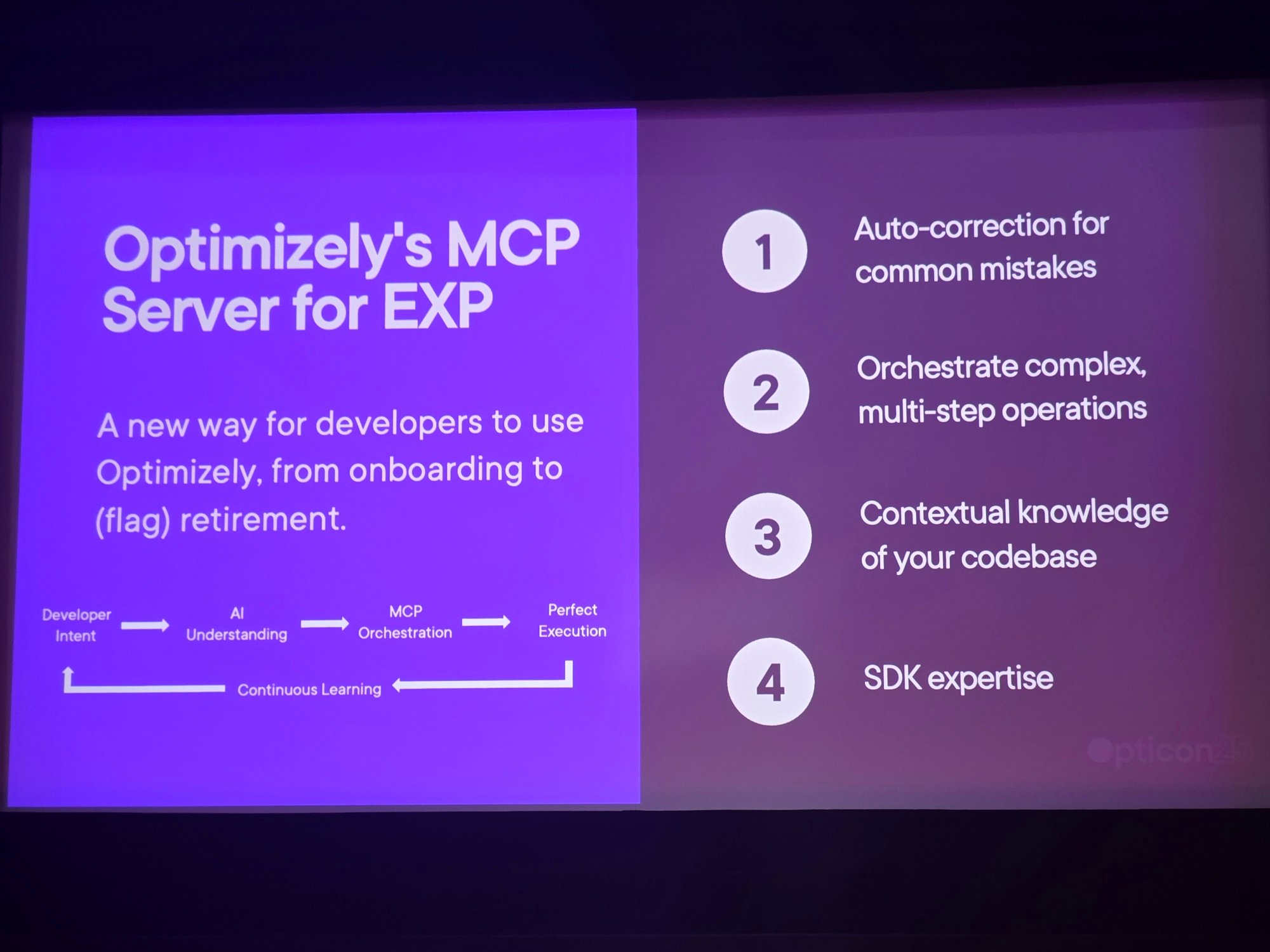
The final breakout session of the day proved to be one of the most forward-thinking discussions I attended. Led by Dejan Dragusin, "AI-powered Feature Experimentation - The emerging MCP server and beyond" explored how AI is transforming the developer experience in feature management and experimentation.
The Pain Points of Modern Development
Dejan began by painting a familiar picture of today's development reality—one that resonated with many developers in the room. He outlined four critical challenges that teams face daily:
Context Switching: Developers constantly juggle between their IDE, documentation sites, Slack conversations, and experimentation platforms. This mental overhead not only fragments focus but significantly impacts productivity. Every switch between tools means losing valuable momentum and having to rebuild your mental model of the problem at hand.
Slow Onboarding: New team members often spend weeks trying to understand existing feature flag implementations, experimentation frameworks, and the various tools in the stack. The learning curve for feature management platforms can be steep, with developers needing to master REST APIs, authentication flows, and platform-specific concepts before they can be productive.
Flag Debt Piles Up: Like technical debt, "flag debt" accumulates when feature flags aren't properly maintained or removed. Old flags linger in the codebase, creating confusion and potential bugs. Teams struggle to keep track of which flags are active, which experiments have concluded, and which flags can safely be removed.
Complex REST API Integrations: Working with feature experimentation platforms typically requires understanding intricate REST API documentation, handling authentication, managing rate limits, and writing boilerplate code just to perform basic operations.
Introducing Optimizely's MCP Server for Experience
Dejan then presented Optimizely's MCP (Model Context Protocol) Server for Experience, currently in closed beta. This represents a fundamental shift in how developers interact with experimentation platforms.
The promise? A dramatically improved developer experience characterized by:
Zero Documentation Lookups: Imagine never having to tab over to API documentation mid-workflow. The MCP server enables AI assistants to understand the platform natively, eliminating the need for constant reference checking.
Zero UI Navigation: No more clicking through multiple screens to create a flag, set up an experiment, or check results. Developers can accomplish these tasks directly from their development environment through natural language interactions.
Zero Copy-Paste from Examples: Gone are the days of hunting for code snippets and adapting boilerplate. The system generates correct, contextual implementations on demand.
Perfect Implementation First Time Round: Perhaps most impressively, the integration promises accurate implementations from the start, reducing the debugging cycle that typically follows initial integration attempts.
The Power of Open Standards
What makes this approach particularly exciting is that it's not locked to a single AI provider. The MCP server architecture allows connection with any LLM, giving teams flexibility in their AI tooling choices. Whether you're using Claude, GPT-4, or another language model, the same powerful feature experimentation capabilities remain accessible.
This open approach represents a mature understanding of the AI landscape—rather than betting on a single AI provider, Optimizely has built infrastructure that can work with the rapidly evolving AI ecosystem.
Closing Thoughts and Networking
As Dejan wrapped up his presentation, the energy in the room was palpable. The session had given us a glimpse into a future where feature experimentation becomes seamless, integrated, and genuinely intelligent. Following this final breakout session, attendees moved into the closing reception, where conversations continued over food and canapés. The networking buzz was filled with discussions about AI's potential to transform not just feature experimentation, but the entire development workflow.
Final thoughts and takeaways
The Central Theme: AI is Here, But Implementation Requires Courage
This year's Opticon revealed how people are grappling with a fundamental tension: AI's transformative potential versus the messy reality of implementation. Tom Fishburn's "awkward adolescence" metaphor perfectly captures where the industry stands—powerful but ungainly, full of promise but not yet fully mature.
Key Strategic Takeaways
1. Start with Outcomes, Not Technology The most compelling insight from Britt Hall's experimentation demo was the shift from "what can we test?" to "what outcome do we want, and how do we get there?" This reversal of traditional approaches should inform all AI adoption strategies—begin with business value, then leverage AI to achieve it.
2. Components Over Complexity Leeds Bradford Airport's approach offers a blueprint: start with reusable blocks, focus on high-value touchpoints (their "Final Planning" and "Ready to Go" phases), and build incrementally. This pragmatic strategy counters the tendency to attempt transformative overhauls that stall before delivering value.
3. The "People Issue" is Paramount Kian Gohar's emphasis that "AI is a people issue" cuts through the technical noise. No amount of sophisticated agents or embedded workflows will succeed without change management, AI literacy (hence learnabc.ai), and cultural transformation. Organizations fixating solely on technology will struggle.
Technical Insights Worth Acting On
Specialized Agents Over Monolithic AI Opal's architecture of purpose-built, specialized agents (rather than one-size-fits-all AI) represents a more practical approach. With 80+ system tools and the ability to build custom agents, this modular strategy allows organizations to solve specific problems rather than boiling the ocean.
MCP Server: A Genuinely Disruptive Development The Model Context Protocol server for feature experimentation deserves particular attention. By eliminating context switching, documentation lookups, and complex REST integrations, it addresses real developer pain points. Its open standard approach (works with any LLM) is strategically smart—it future-proofs the investment.
Embedded > Bolted-On A recurring theme across sessions: AI that's woven into existing workflows succeeds where add-ons fail. Whether it's Opal's embedded architecture or Commerce Connect's AI-charged workflows, integration beats isolation.
The Experimentation Culture Imperative
Grant Thornton's four-pillar framework (Governance, Onboarding, Experimentation Leads, Community) provides a practical roadmap for organizations moving beyond ad-hoc testing. The radical simplification from 150 to 19 content blocks underscores an important principle: sometimes transformation requires subtraction, not addition.
Practical Next Steps for Attendees
- Audit Your Starting Point: Where are you genuinely experiencing pain that AI could address? Don't solve theoretical problems.
- Build AI Literacy: Invest in foundational understanding across teams—the technology moves too fast for knowledge to remain siloed with specialists.
- Start Small, Think Big: Follow the Leeds Bradford Airport model—pragmatic components that build toward ambitious goals.
- Champion the Culture Shift: Identify your experimentation leads, establish governance, create community. The technical capabilities mean nothing without organizational readiness.
- Evaluate Your Tech Stack: If you're on older versions of Commerce Connect or Configured Commerce, the upgrade path to AI capabilities is clear—and necessary.
The Underlying Question
Alex Atzberger framed it perfectly in the opening session: "The question isn't whether AI will transform how you work—it's whether you'll lead that transformation or be left behind."
The information that I learnt during my day at Opticon suggests the tools are ready, the roadmap is clear, but success will belong to those who couple technical capability with organizational courage—leaders willing to challenge workflows, empower teams, and make decisions even when the path isn't completely clear.
The awkward adolescence phase won't last forever. The organizations that learn to work alongside AI now, imperfections and all, will be the ones who thrive when it matures.


A fabulously thorough write up, Graham. Well done. Really insightful and useful👍
Great summary and much appreciated.